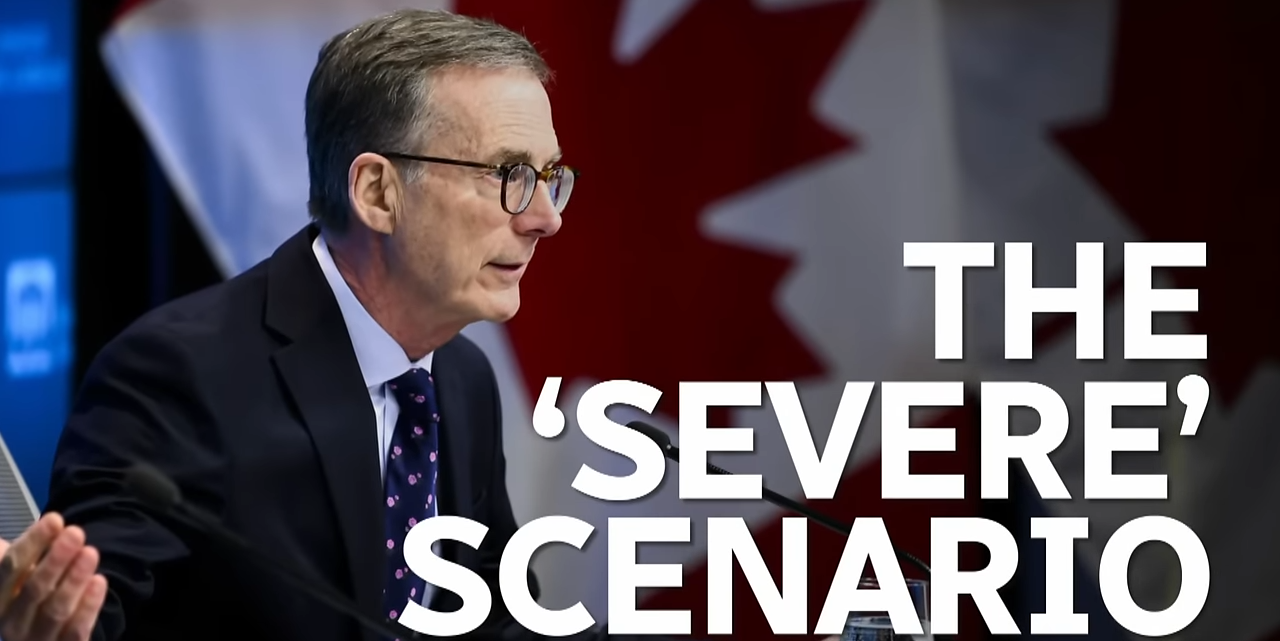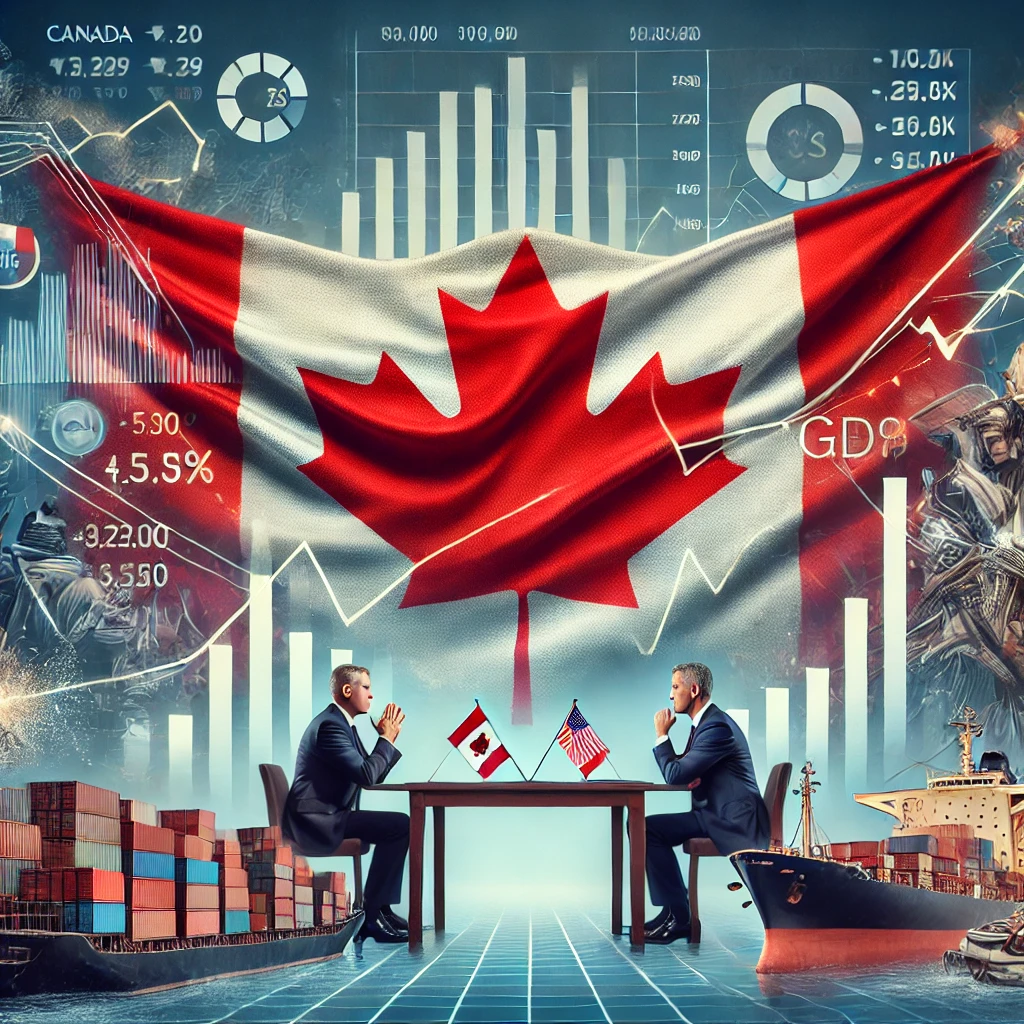Introduction: A New Era of Economic Uncertainty
Canada is facing a potential economic storm as trade tensions with the U.S. escalate, threatening exports, inflation, and economic stability. The Bank of Canada’s (BoC) latest interest rate decision, which included a 0.25% rate cut, signals an attempt to manage economic turbulence. However, the broader picture is complex—if the U.S. moves forward with 25% tariffs across all Canadian exports, retaliatory measures could trigger a downturn in trade, higher prices, and a possible recession.
At the heart of this issue is a policy dilemma: Should Canada lower interest rates to stimulate the economy, or raise them to combat inflation caused by higher import costs? This article breaks down the key discussions from the Bloomberg New Economy program, the possible economic fallout, and what lies ahead for Canada’s financial stability.
Key Discussions and Economic Implications
- The Immediate Impact: Trade Tensions and Canada’s Economic Exposure
The BoC’s latest decision comes amid fears that U.S. tariffs could severely hurt Canadian exports. Since the U.S. is Canada’s largest trading partner, a 25% tariff on Canadian goods could significantly reduce demand, particularly in key industries such as oil, manufacturing, and agriculture.
How Tariffs Could Reshape Trade:
- Reduced Export Volume → American companies may import fewer Canadian goods due to higher costs.
- Falling Commodity Prices → Lower demand for Canadian oil, timber, and metals could result in price drops, further harming the economy.
- Job Losses → Manufacturing and resource sectors could see mass layoffs, affecting hundreds of thousands of workers, particularly in Ontario and Alberta.
- Retaliatory Tariffs → Canada could impose taxes on American imports, making everyday essentials (fruits, vegetables, electronics, medicines) more expensive.
The Bank of Canada acknowledged the potential for GDP contraction ranging from 2.2% to 3%, with a recession likely if the worst-case scenario materializes.
- The Inflation vs. Interest Rate Dilemma: A No-Win Scenario?
Traditionally, the Bank of Canada lowers interest rates during economic downturns to stimulate borrowing and spending. However, tariffs create an unusual problem, they drive up inflation because imported goods become more expensive. This puts the BoC in a policy trap:
- Lowering rates could stimulate economic growth but also risk fueling inflation further.
- Raising rates could control inflation, but at the cost of pushing Canada into a deeper recession.
Canada’s Inflation Predicament:
- Higher tariffs on U.S. imports mean essential goods (e.g., food, electronics, automobiles) will cost more, driving inflation upward.
- The BoC’s primary role is to keep inflation stable—in past crises, it has raised rates aggressively to curb rising prices.
- However, if tariffs cause economic contraction, rising rates could worsen the downturn instead of controlling inflation.
This monetary policy paradox leaves Canada’s central bank with few clear options. The BoC admitted that it cannot counter the effects of a prolonged trade war, making long-term economic forecasting uncertain.
- Potential Scenarios: What Happens Next?

Given the uncertainty surrounding U.S. trade policies, several economic scenarios could unfold:
Scenario 1: Full-Scale Tariff War (Worst Case)
- The U.S. imposes a blanket 25% tariff on Canadian exports.
- Canada retaliates with high tariffs on American goods, increasing consumer costs.
- Exports decline, businesses lay off workers, and the Canadian economy contracts by 3% or more.
- Inflation spikes, forcing the BoC to raise rates, deepening the recession.
Scenario 2: Partial Tariff Implementation (Moderate Case)
- The U.S. applies tariffs only on select industries (e.g., oil and steel), limiting but not eliminating trade disruption.
- The BoC adopts a mixed policy, cutting rates slightly while monitoring inflation.
- The Canadian dollar weakens, making exports slightly more competitive.
- GDP growth slows but remains positive, avoiding a full-blown recession.
Scenario 3: De-Escalation (Best Case)
- Diplomatic negotiations ease trade tensions, preventing harsh tariffs.
- Canada focuses on diversifying trade with Europe and Asia to reduce reliance on the U.S.
- The BoC holds rates steady, letting market forces stabilize inflation.
- The Canadian economy continues to grow, albeit at a slower pace.
Future Predictions: Navigating an Uncertain Economic Future
For Businesses:
- Prepare for Rising Costs → Companies reliant on U.S. imports must adjust pricing strategies to absorb potential tariff-related cost increases.
- Diversify Supply Chains → Exploring European, Asian, and Latin American markets could provide alternative trading partners.
- Monitor Interest Rate Trends → Firms with high debt levels should plan for rate fluctuations that could impact borrowing costs.
For Consumers:
- Expect Higher Prices → Everyday goods, particularly food, electronics, and household items, could see price hikes.
- Interest Rate Sensitivity → Mortgage holders should prepare for potential interest rate volatility, impacting homeownership affordability.
For Policymakers:
- Consider Fiscal Interventions → The government could use tax breaks or direct subsidies to support businesses and low-income consumers.
- Strengthen Trade Diversification → Expanding agreements with Asia-Pacific (CPTPP) and Europe (CETA) could mitigate risks of overreliance on U.S. trade.
Closing Thoughts: The Road Ahead
Canada stands at a critical crossroads. The potential for a full-blown trade war with the U.S. poses a major risk to economic stability, job security, and inflation control. Policymakers, businesses, and consumers must prepare for all possible outcomes.
Fruit for Thought:
- Can Canada negotiate trade agreements that mitigate potential U.S. tariff fallout?
- Will the Bank of Canada prioritize economic stimulus or inflation control in the coming months?
- How can businesses shield themselves from tariff-related shocks while maintaining competitiveness?
The answers to these questions will shape Canada’s economic trajectory, influencing its resilience against future trade disruptions. As global markets watch closely, Canada’s response will serve as a case study in navigating economic uncertainty in a rapidly shifting world.
Disclaimer:
This article is based on insights shared during Bloomberg’s coverage of the Bank of Canada’s interest rate decision and trade policy discussions. It is intended for informational purposes only and does not constitute financial, investment, or policy advice. Readers are encouraged to consult experts for personalized guidance.
Author Bio:
Michael Carter
Michael Carter is a seasoned financial analyst with a CFA designation and 10 years of experience covering banking trends, market strategies, and fintech innovations.
Emma Novak is a wealth management specialist focused on sustainable investing. Her work has been featured in Forbes, Bloomberg, and other leading financial outlets.



